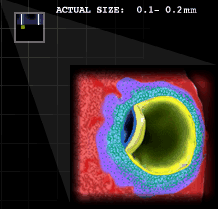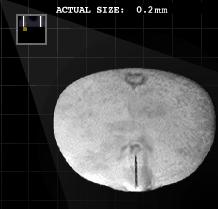weight: 102
waist: 27 inches
The developing baby is still tiny. It is about 0.014-0.04 inch (0.36-1mm) in length. The implanted blastocyst is embedded more deeply into the uterine lining. The amniotic cavitiy, which will be filled with amniotic fluid, is starting to form. The placenta, which plays an important role in hormone production and transport of oxygen and nutrients, is forming. Vascular networks that contain maternal blood are establishing.
I am going to be optimistic and assume this pregnancy is going to stick. I gave blood at the lab and should have the results tomorrow sometime. I hope they are really good and don't leave me in a state of not knowing.
From my pregnancy calendar:
The blastocyst continues growing. It will firmly attach to the endometrium of the uterus over the next few days.
From Visembryo:
 Implantation Complete, Placental Circulation System Begins
Implantation Complete, Placental Circulation System Begins0.1 - 0.2 mm
7 - 12 days post-ovulation
Trophoblast cells engulf and destroy cells of the uterine lining creating blood pools, both stimulating new capillaries to grow and foretelling the growth of the placenta. The inner cell mass divides, rapidly forming a two-layered disc. The top layer of cells will become the embryo and amniotic cavity, while the lower cells will become the yolk sac.
Formation of the placenta
The ideal implantation site is the back wall of the body of the uterus towards the mother's spine.
 Gastrulation, Chorionic Villi Formation
Gastrulation, Chorionic Villi Formation0.2 mm
13 days post-ovulation
Chorionic villi "fingers" in the forming placenta now anchor the site to the uterus.
The formation of blood and blood vessels of the embryo begins in this stage. The blood system appears first in the area of the "placenta" surrounding the embryo, while the yolk sac begins to produce hematopoietic or non-nucleated blood cells.
By the end of stage 6a, the embryo is attached by a connecting stalk (which will later become part of the umbilical cord), to the developing placenta.
Stage 6b begins when a narrow line of cells appears on the surface of the embryonic disc. This primitive streak is the future axis of the embryo and it marks the beginning of gastrulation, a process that gives rise to all three layers of the embryo: ectoderm, mesoderm and endoderm.


No comments:
Post a Comment